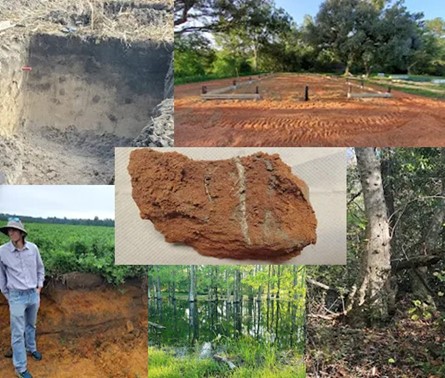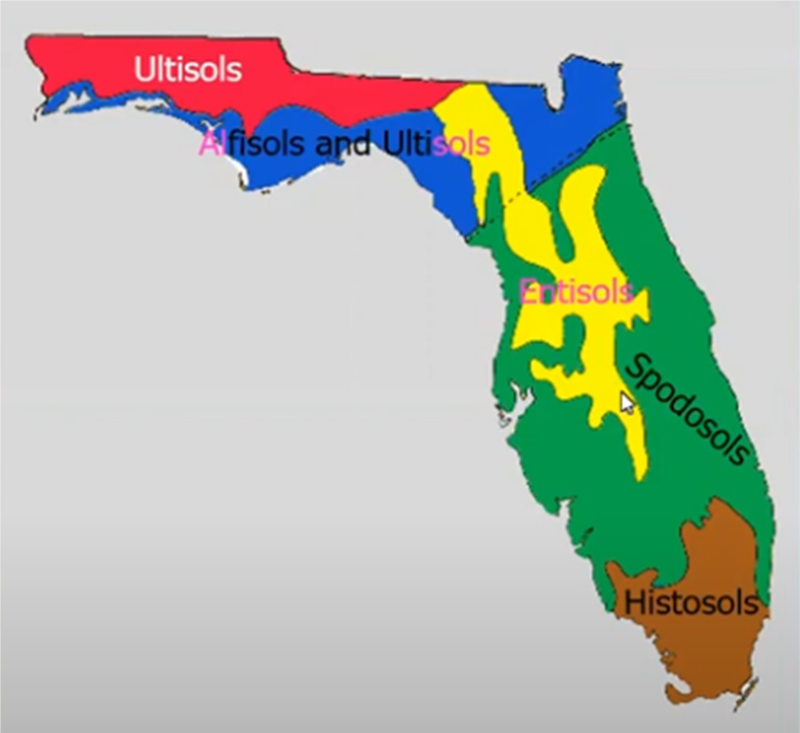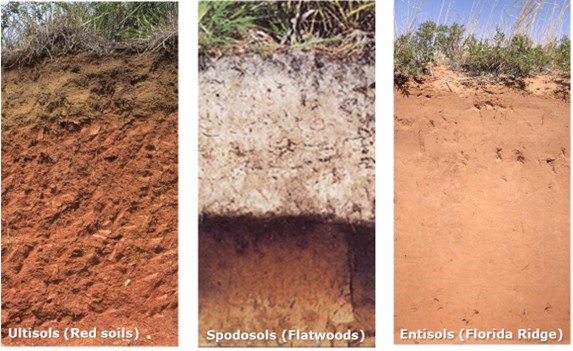Dr. Cheryl Mackowiak, UF/IFAS Soil Scientist, North Florida Research and Education Center – Quincy
Soil is more than dirt. A healthy soil supports a healthy ecosystem and society. As Franklin Delano Roosevelt aptly stated, “A nation that destroys its soil, destroys itself”.

Figure 1. Florida soils vary in color, texture and have various attributes. Clockwise from top left. Deep sands at Suwannee County used for irrigated agriculture, red soils used for building foundations, rich soils of ephemeral and perennial wetlands hold carbon, fertile red soils of Jefferson County support dryland agriculture. Middle: old root and worm channels help move water and nutrients from the soil surface to the root zone. Credit: Cheryl Mackowiak, UF/IFAS
We have a human-centric view of our planet and the resources on it, including soil. For a resource to be considered valuable by society, it must benefit us (Figure 1 right). If we can identify and measure the benefits, we can assign monetary value to the resource and thereby also protect it from depletion or irreparable harm. Additionally, society may compensate the caretakers of those resources.
A fresh approach for describing our natural resources is in terms of ‘Ecosystem Services’. It refers to the goods and services an ecosystem (or component) provides society. There are four different ecosystem service types. From the soil perspective, they are: 1) Provisioning service (products, such as food, antibiotics, building materials), 2) Regulating service (directs or helps regulate, such as water purification and storage and carbon sequestration), 3) Supporting services (processes that underlie ecosystem function, such as water and nutrient cycling and biodiversity), and 4) Cultural services (provides spiritual, intellectual, or recreational benefits, such as cemeteries, hiking, gardening).
Florida soils (see Agricultural Soils of Florida) provide many ecosystem services that you might not have considered. Food production is an obvious service, but did you know that nearly 300 different commodity crops are grown in the state? In 2019, this resulted in over 140,000 jobs and $11.3 billion in direct sales revenue. Interestingly, most of this farm acreage is in central and south Florida, while Jackson, Holmes, and Walton counties each have from 100,000 to 300,000 acres of farmland. Florida citrus, beans, peppers, tomatoes, watermelon, and sweet corn receipts represent at or near the top production in the U.S., while nearly 40% of Florida’s total land area is in forest, which supports another $500 million in sales revenue and over 5,000 jobs.
Florida soils and geologic formations contribute greatly to the quality of our groundwater resources. For example, the Floridan aquifer, which is beneath all of Florida, averages 1,000 feet thick. As people utilize this resource, it is continuously recharging as rainwater passes through our sandy soils (average annual rainfall rates are over 50 inches per year), helping to make it one of the most productive aquifers in the world. If soils where of a heavier texture, aquifer recharge rates would be greatly reduced. In comparison, over 30% of Florida is wetland habitat and 90% of that are freshwater wetlands. Wetland soils are among the largest carbon stores on the planet. This storage capacity helps to regulate climate, water supplies and biodiversity. Additionally, one of our major soil types, Flatwood soils (Spodosols soil order and from the Greek ‘spodos’ or wood ash), are characterized by an accumulation of organic carbon and these soils represent nearly 30% of Florida soil types (Figure 2). In fact, it is estimated that Florida has more soil carbon than any other state. At some point, this feature may benefit landowners who are interested in carbon credit markets (another potential ecosystem service provided by Florida soil!).
–
Florida soils are quite sandy, so it is no surprise that sand mining operations are located here. However, sand quality is important. The purest and most valuable deposits are located along the Central Florida Ridge, which is represented by deep, sandy (Entisols soil order) soil types (Figure 3). This location is represented by prehistoric, weathered sand dunes, which now provide a provisional ecosystem service (high quality sand). In the Eastern Florida Panhandle, attapulgite clay (Fullers Earth) is mined at a few locations and is associated with certain Florida red soils (Ultisols soil order). These deposits formed, along with their associated soils, in the geologic past. Southwest Georgia/North Florida is one of the largest natural sources of high quality attapulgite clay in the world. These deposits can be found close to the soil surface and are therefore surface mined. Its properties make it a valuable industry additive to paint products, agricultural suspensions, and used in filters and absorbents, and anti-corrosion coatings, to name a few.

Figure 3. Stylized representation of Florida soil order distribution: Ultisols, Entisols, Spodosols, and Histosols. Histosols are also known as muck soils. Credit: Rao Mylavarapu, UF/IFAS
–
We have just begun to scratch the surface of Florida soils in terms of the ecosystem services they provide society. You likely can think of many more services from the soil beneath your feet provide to you and your community. Soil covers 25% of the Earth’s surface and a mere 10% of that surface produces food. To learn more about healthy soils and what folks around the country are doing to build and conserve this precious natural resource, consider viewing the hour-long video below published by the Soil Health Institute.
- Grower Survey Insights on Cotton Nitrogen Management in Florida’s Panhandle - July 18, 2025
- Florida Soils are an Indispensable Natural Resource - January 10, 2025
- Regenerative Agriculture: What it Means to You - June 21, 2024

